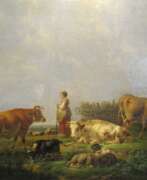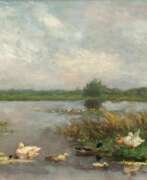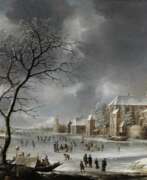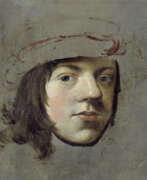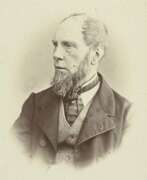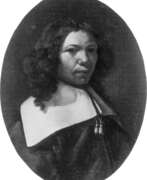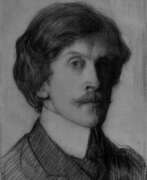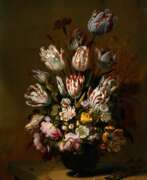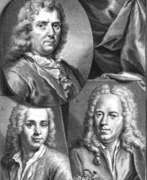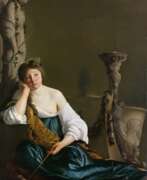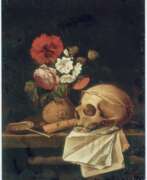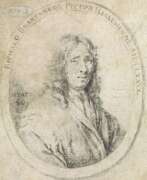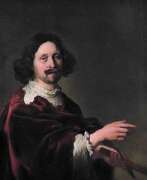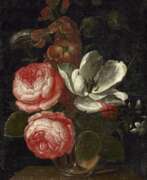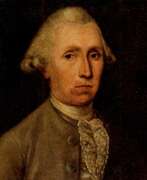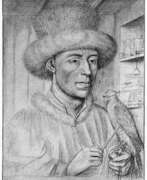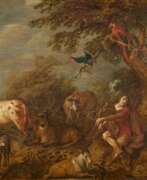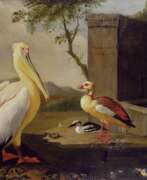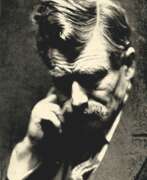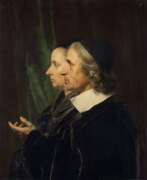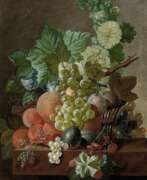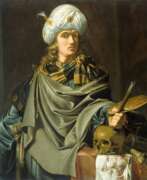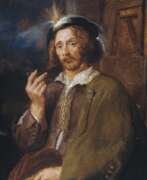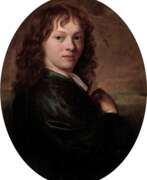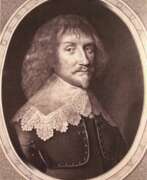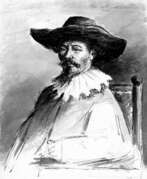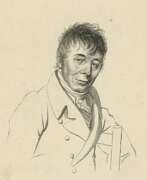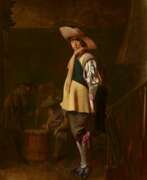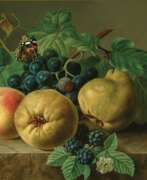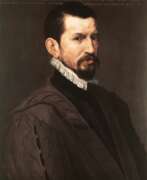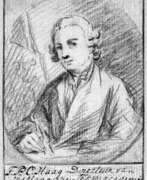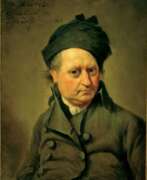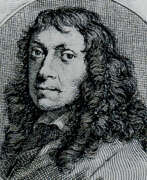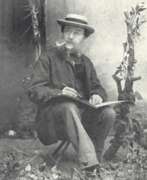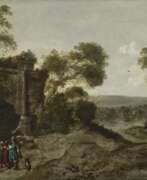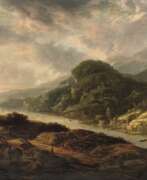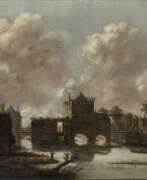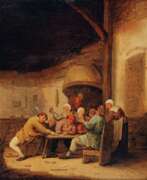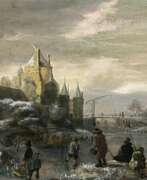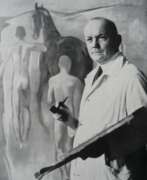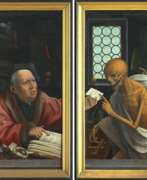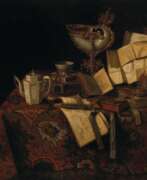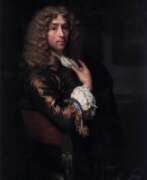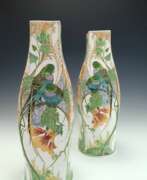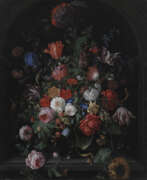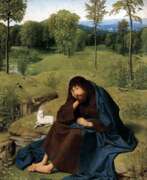Artists Dutch School
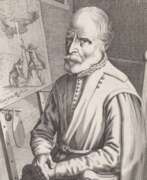

Pieter Aertsen, a Dutch painter born in 1508 in Amsterdam and known as ‘Lange Pier’ for his height, was a significant figure in the Northern Mannerism style. His artistic journey began with religious paintings, but he became renowned in the 1550s for his pioneering work in domestic scenes, where he vividly portrayed everyday objects like furniture, cooking utensils, and food.
Pieter Aertsen is credited with inventing the monumental genre scene, a novel concept in painting that combined still life and genre painting, often incorporating a biblical scene in the background. This style is exemplified in his work "Butcher's Shop" (1551), which is considered the earliest example of Mannerist inversion of still life in Northern painting. In this work, the everyday subject matter of a butcher's stall is given more prominence than the historical or religious scene depicted in the background.
Pieter Aertsen's work reflected the rich mercantile culture of Antwerp, where he lived for many years before returning to Amsterdam in 1556. His paintings often included a wide range of subjects, from market scenes to kitchen tableaux, filled with an abundance of fruits, vegetables, meats, and other food items. His unique approach to painting, which combined the teachings of classical art with the ideas of contemporary artists, made a lasting impact on the genre.
In addition to his genre scenes, Pieter Aertsen continued to create religious works throughout his life, although many were lost during the waves of iconoclasm that swept across northern Europe during the Protestant Reformation. A surviving religious work of his is the "Crucifixion" in the Royal Museum of Fine Arts Antwerp.
Pieter Aertsen's legacy continued through his pupils, including Stradanus and his nephews, Joachim Beuckelaer and Huybrecht Beuckeleer. His influence on the development of still life and genre painting was profound, and his works remain a fascinating study for collectors and experts in art and antiques.
To stay informed about the latest updates, sales, and auction events related to Pieter Aertsen's art, consider signing up for our newsletter. This way, you'll never miss an opportunity to explore and possibly acquire works from this master of genre and still life painting.


Pieter Angellis, also known as Pieter van Angellis, Peter van Angellis or Peter Angelles, was a French-born painter. He worked in Flanders, Germany, Italy, England, and France and is known for his landscapes and genre paintings of urban life. Angelles was a member of the Guild of St. Luke in Antwerp and Düsseldorf.
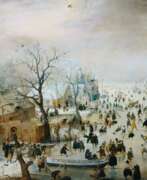

Hendrick Avercamp was a seminal Dutch painter during the Dutch Golden Age. He is celebrated as one of the earliest landscape painters of the 17th-century Dutch school, specializing in vibrant winter scenes of the Netherlands. His paintings are filled with colorful and lively depictions of people engaging in various activities against the backdrop of the Dutch winter landscape.
Educated by the Danish-born portrait painter Pieter Isaacsz, Hendrick Avercamp's work reflects a strong influence from the Flemish painting tradition, especially evident in the landscapes reminiscent of Pieter Bruegel the Elder. His technique of aerial perspective, where objects in the foreground are painted with richer colors than those in the distance, creates a remarkable impression of depth in his paintings.
Hendrick Avercamp's most ambitious and acclaimed work, 'Winter Landscape with Ice Skaters', painted around 1608, is a detailed panorama of human and animal activities during a harsh winter. This painting, along with others like 'Winter Landscape with a Frozen River and Figures' and 'Winter Landscape with Skates and People Playing Golf', showcase his knack for narrative, capturing various facets of 17th-century Dutch society enjoying the winter season.
Despite being mute and probably deaf, Hendrick Avercamp's keen observation skills are evident in his works, where he intricately portrays diverse classes engaging in various winter activities. He produced about a hundred paintings, many of which can be seen in the Rijksmuseum in Amsterdam and the Mauritshuis in The Hague. His work was also celebrated for its historical quality, providing a glimpse into the life of different societal levels in the Netherlands at that time.
For collectors and enthusiasts of art and antiques, Hendrick Avercamp's paintings offer a fascinating window into the Dutch Golden Age, with their vivid portrayal of life and activities in a winter setting. His works, characterized by meticulous detail and a cheerful narrative, remain an integral part of the conversation in the history of Dutch art.
To stay updated on the latest insights and collections related to Hendrick Avercamp's works, consider subscribing to our updates. Stay informed about new sales, exhibitions, and auction events featuring this master of Dutch winter landscapes.


Barent Avercamp was a Dutch painter. He was taught by his uncle Hendrick Avercamp, who was also a painter. Barent primarily painted scenes depicting Netherlands in winter. He was a member of the Guild of Saint Luke, and traveled around the Netherlands including Zwolle and Zutphen for his settings and inspiration.


Nicolaes Pieterszoon Berchem was a highly esteemed and prolific Dutch Golden Age painter of pastoral landscapes, populated with mythological or biblical figures, but also of a number of allegories and genre pieces.
He was a member of the second generation of "Dutch Italianate landscape" painters. These were artists who travelled to Italy, or aspired to, in order to soak up the romanticism of the country, bringing home sketchbooks full of drawings of classical ruins and pastoral imagery. His paintings, of which he produced an immense number, (Hofstede de Groot claimed around 850, although many are misattributed), were in great demand, as were his 80 etchings and 500 drawings. His landscapes, painted in the Italian style of idealized rural scenes, with hills, mountains, cliffs and trees in a golden dawn are sought after. Berchem also painted inspired and attractive human and animal figures (staffage) in works of other artists, like Allaert van Everdingen, Jan Hackaert, Gerrit Dou, Meindert Hobbema and Willem Schellinks.
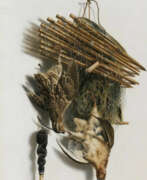

Jacob Biltius or Jacobus Biltius was a Dutch still life painter originally from The Hague who worked in various places including The Hague, Amsterdam, Maastricht, Antwerp, Leeuwarden and Bergen op Zoom. He was known for his game still lifes, kitchen still lifes and trompe-l'œil still lifes.
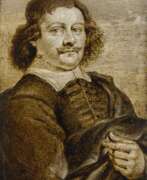

Jan Dirksz Both was a distinguished Dutch painter, draughtsman, and etcher renowned for his pivotal role in the evolution of Dutch Italianate landscape painting. His journey into the arts began in Utrecht, learning from his father before becoming a pupil of Abraham Bloemaert. Both's career took a significant turn when he, alongside his brother Andries, ventured to Rome, absorbing the influence of Claude Lorrain and contributing to projects such as the Buen Retiro Palace in Madrid.
By the mid-1640s, Jan had returned to Utrecht, further honing his craft to produce expansive landscapes illuminated by a Mediterranean glow, notable for their mixture of realism in the foreground against idyllic backgrounds. Noteworthy pieces include "Landscape with Bandits Leading Prisoners" and "Judgement of Paris," showcasing his mastery in blending naturalistic details with mythological and religious figures. His landscapes, characterized by their golden light and imaginative vistas, earned him a place among the leading masters of the Italianate trend in Dutch landscape painting.
Jan Both's legacy is preserved in prestigious collections worldwide, including the Fitzwilliam Museum, the Hermitage, the Kunsthistorisches Museum, the Louvre, and the National Gallery, among others. His work reflects a significant Italian influence merged with his native Dutch sensibilities, marking him as a key figure in the 17th-century art scene.
For collectors and experts in art and antiques, Jan Dirksz Both's oeuvre offers a fascinating glimpse into the blend of Dutch and Italian influences that characterize the Italianate landscape painting tradition. His contributions not only enriched Dutch art but also provided a bridge between the Renaissance and Baroque periods, capturing the beauty of landscapes with a unique, poetic light.
To explore more about Jan Dirksz Both's contributions to art and to stay informed about exhibitions or sales featuring his work, signing up for updates from art institutions can offer exclusive insights into the world of this influential Dutch painter. This subscription ensures enthusiasts and collectors are well-informed about developments related to Both's oeuvre, enhancing their appreciation and understanding of his artistic legacy.


Szymon Buchbinder was a Polish painter of the late nineteenth and early twentieth centuries of Jewish origin. He is known as a genre painter and portraitist.
Szymon Buchbinder created genre-historical paintings, often with moral overtones, as well as portraits executed in small formats. Many of the subjects were related to Jewish culture and customs. The style of Buchbinder's painting is considered by critics to be in the tradition of the old Dutch school of painting.


Jacob Cats was a Dutch painter, printmaker and graphic artist.
He was famous for his urban landscapes and landscapes with realistic portrayals of people and animals. His works were distinguished for their originality, poetic rendering of the features of nature and depth.
His works are represented in almost all major public collections in the Netherlands.
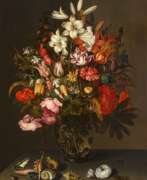

Anthony Claesz the Younger was a Dutch painter who worked on floral still lifes during the Golden Age of Dutch painting.
Anthony Claesz's paintings are generally constructed with great attention to detail, and he was particularly adept at depicting the play of light and shadow on reflective surfaces.
During his lifetime, Anthony Claesz the Younger was highly respected and was a member of the St. Luke's Guild in Amsterdam. His work can be found in many museums and galleries around the world, including the Rijksmuseum in Amsterdam, the National Gallery in London and the Metropolitan Museum of Art in New York.
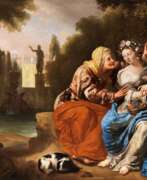

Hermannus Collenius was a Dutch Baroque painter.
The portraits of Hermannus Collenius were characterised by classical elegance and an emphasis on the facial features and clothing of the portrayed subject. The painter often portrayed his sitters according to the latest fashions, which contributed to the popularity of his portraits among the fashionable elite.


Aelbert Jacobsz. Cuyp was a Dutch Baroque painter, graphic artist and printmaker.
Aelbert is the successor of a dynasty of painters from Dordrecht. He was one of the leading Dutch landscape painters of the Dutch Golden Age. A pupil of his father, the painter Jacob Gerritsz. Cuyp (1594-1651), he is known primarily for his landscapes of the Dutch countryside in the light of early morning or late evening. But Aelbert Cuyp also painted canvases on biblical, mythological, and historical themes, still lifes, and portraits. The Italian style is evident in his works.
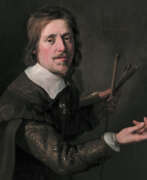

Gijsbert d'Hondecoeter was a Dutch landscape and animalier painter.
Hondecoeter belonged to a family of painters. His father was Gillis d'Hondecoeter and his son was Melchior d'Hondecoeter. Hondecoeter primarily painted works of barnyard fowl. Some of his works can be found at the Rijksmuseum Amsterdam. He became a member of the Guild of St. Luke in Utrecht in 1629. After he died in 1653, his brother-in-law and artist Jan Baptist Weenix continued the training of his son Melchior.


Jan de Baen was a Dutch portrait painter who lived during the Dutch Golden Age. He was a pupil of the painter Jacob Adriaensz Backer in Amsterdam from 1645 to 1648. He worked for Charles II of England in his Dutch exile, and from 1660 until his death he lived and worked in The Hague. His portraits were popular in his day, and he painted the most distinguished people of his time.


Aert de Gelder was a Dutch painter. He was the only Dutch artist to paint in the tradition of Rembrandt's late style into the 18th century.
As author of biblical scenes and portraits his style was inspired by Rembrandt's, using his artistic ideas, well into the 18th century, without being influenced by contemporary new fashions. From the artistic point of view his work can not be considered as passive imitation of the master; indeed, it stands for inventiveness in the narrative, taste for the theatrical and a strong emotional charge of the characters. All these traits made him one of the most important interpreters of Dutch painting of the late seventeenth century.


Jacob de Gheyn III was a Dutch artist, painter and printmaker of the Golden Age.
He was the son of Jacob de Gheyn II, canon of Utrecht, engraver and graphic artist, a favorite royal artist who designed a garden in The Hague for the royal family. And his grandfather was a miniaturist and glass painter. De Gheyn learned etching from his father, then studied in Leiden with Constantin and Maurits Huygens. Thanks to his rich inheritance, he did not bother to work. After traveling to London and Sweden in 1620, Jacob de Gheyn III lived in The Hague and then moved to Utrecht, where he became a canon of St. Mary's Church and lived until the end of his life.
Jacob de Gheyn III patronized Rembrandt, who painted a portrait of him in 1632. This portrait has become famous in modern times for being mentioned in the Guinness Book of Records as the most frequently stolen painting and even bears the nickname "Rembrandt to take away".


Willem de Heusch is a Dutch landscape painter and printmaker.
Willem de Heusch probably studied under Jan Both, as he later painted and etched entirely in his style. De Heusch signed his paintings with his full name beginning with a monogram.
Willem de Heusch was known for his realistic depictions of Dutch landscapes. He used a naturalistic style in his works that was characterized by his attention to detail and skilful use of light and shade.
Although Heusch's style is identical to Botha's, both masters may have been influenced by Claude Lorrain, whose Arcadian art they imitated, during their travels in Italy. Heusch sometimes sketched landscapes for the battle paintings of Jan Molenard.


Pieter de Hooch was a Dutch Golden Age painter famous for his genre works of quiet domestic scenes with an open doorway. He was a contemporary of Jan Vermeer in the Delft Guild of St. Luke, with whom his work shares themes and style.
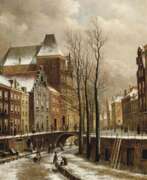

Oene Romkes de Jongh was a 19th century Dutch landscape painter. He is known for his detailed urban views. He painted mainly landscapes of Amsterdam and domestic scenes around Lake Eijsselmer. De Jongh was particularly influenced by Cornelis Springer.


Pieter de Ring was a Dutch painter who specialised in still lifes. He became famous for his rich banquet depictions of fruit, shrimp, oysters, musical instruments, books and precious objects such as nautilus shells or Chinese porcelain.
In his youth, he worked as a bricklayer during the day and drew in the evening; the other family members all worked in the fabric industry. After painting a number of pictures, he apprenticed himself to Jan Davidsz. de Heem with his grandfather's permission. In 1647 he became a founding member of the Guild of Saint Lucas.
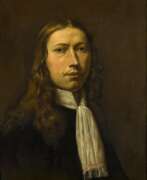

Adriaen van de Velde was a Dutch painter, draughtsman and print artist. His favorite subjects were landscapes with animals and genre scenes. He also painted beaches, dunes, forests, winter scenes, portraits in landscapes, as well as mythological and biblical scenes. He belongs to a group of painters referred to as the Dutch Italianate painters, who combined Dutch agricultural landscapes with mythological or Arcadian scenes in Italian settings. His paintings are characterised by their delicate, careful composition and his mastery of lighting effects as well as the human figure.
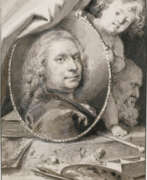

Jacob de Wit was a Dutch painter, decorator and collector, a member of the Guild of St. Luke in Antwerp.
De Wit studied at the Royal Academy in Antwerp, where he began to study the work of Peter Paul Rubens and became his follower. De Wit made copies of many of Rubens' works, notably his ceiling paintings in the Jesuit church in Antwerp.
Later, from the 1720s Jacob de Wit began working in Amsterdam, where he received regular commissions, both public and private. He created many ceiling and wall paintings in the Rococo style, in which he used grisaille - gray and white painting, creating the illusion of three-dimensionality, or bas-relief. Some of them can still be seen in their original places in the 21st century.
Jacob de Wit amassed a large art collection during his lifetime, including works by Rubens, Antoni van Dyck, as well as Dutch and Flemish contemporaries and old masters.
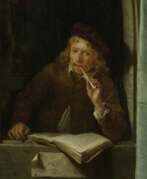

Gerard Dou was a Dutch Golden Age painter, whose small, highly polished paintings are typical of the Leiden fijnschilders. He specialised in genre scenes and is noted for his trompe-l'œil "niche" paintings and candlelit night-scenes with strong chiaroscuro. He was a student of Rembrandt.


Louis Fabricius Dubourg (Louis Fabritius du Bourg) was an historical and academic painter of arcadian landscapes, and an engraver.
He was a pupil of Gerard de Lairesse, Gerrit Rademaker (1672-1711) and Jacob van Huysum. In 1718 he became sexton of a small wooden church on Kerkstraat. Around 1726 he was practising foreshortening and may have been a member of an academy; he produced a lot of nude (art) during his life.


Jacob Duck was a Dutch artist, celebrated for his etchings and paintings that vividly capture the essence of daily life, military scenes, and figures during the Dutch Golden Age. Born around 1600 in Utrecht, Jacob Duck initially trained as a goldsmith before turning his focus to painting, under the guidance of Joost Cornelisz Droochsloot. His journey took him from Utrecht to Haarlem and finally to The Hague, showcasing his adaptability and the breadth of his work across different Dutch cities.
Jacob Duck's artistry is distinguished by its intimate portrayal of soldiers and everyday scenes, marked by a keen observation of social interactions and the human condition. His works, housed in prestigious museums like the Hermitage Museum, underscore his significant contribution to art and culture, bridging the gap between the personal and the universal in the 17th century Dutch society.
One of his notable works, "A Couple in an Interior with a Fortune-Teller," housed at The Metropolitan Museum of Art, exemplifies Duck's unique approach to narrative in art. This painting diverges from the era's typical jovial depictions of fortune-tellers by presenting a scene charged with a palpable tension, reflecting Jacob Duck's ability to infuse his works with depth and complexity. The painting's intricate details and the backstory of its subjects further illuminate Duck's skill in blending storytelling with visual artistry, making him a pivotal figure in Dutch painting.
For collectors and art experts, Jacob Duck's oeuvre offers a fascinating glimpse into the Dutch Golden Age's socio-cultural landscape, characterized by a meticulous attention to detail and a profound understanding of human emotions. His legacy continues to captivate and inspire, underscoring the enduring relevance of his work in the realms of art and history.
To stay informed about new discoveries, sales, and auction events related to Jacob Duck's works, consider signing up for updates. This subscription service is designed exclusively for enthusiasts eager to deepen their appreciation of Duck's artistry, ensuring you're always in the know about opportunities to engage with his timeless creations.
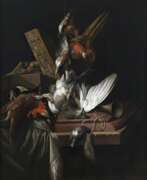

William Gowe Ferguson was a Scottish-born painter who worked and lived in the Netherlands.
Dutch artists of the Gilded Age influenced Ferguson's painting. He was known in Utrecht, The Hague and Amsterdam for his many still lifes with beaten game and hunting ammunition.


Barend Gael was a Dutch painter and graphic artist of the Dutch Golden Age of painting. He was a pupil of Philips Wouwerman.
Barend Gael was an accomplished painter of Italian landscapes and was known at the Guild of St. Luke's in Haarlem by 1642.
Gael's paintings are noted for their precise composition and use of light and shadow. He often used dark backgrounds to create a sense of depth and contrast, and skillfully used light to emphasise the texture and detail of figures.
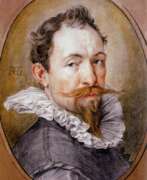

Hendrick Goltzius was a German-born Dutch printmaker, draftsman, and painter. He was the leading Dutch engraver of the early Baroque period, or Northern Mannerism, lauded for his sophisticated technique, technical mastership and "exuberance" of his compositions. According to A. Hyatt Mayor, Goltzius "was the last professional engraver who drew with the authority of a good painter and the last who invented many pictures for others to copy". In the middle of his life he also began to produce paintings.


Jan Griffier the Younger was an 18th-century painter active in England.
According to the Netherlands Institute for Art History he was the son of Jan Griffier I and the younger brother of Robert. He lived on Pall Mall and influenced the painter Christian August Lorentzen.


Gabriël Gruppello was a Flemish Baroque sculptor who produced religious and mythological sculptures, portraits and public sculptures. He worked in Flanders, France and Germany. He was a virtuoso sculptor who enjoyed the patronage of several European rulers.


Frans Hals was a Dutch painter who painted during the so-called Golden Age. He is considered to be one of the most important old Dutch masters. As far as is known, Frans Hals worked all his life in Haarlem and became best known for his lively and colourful paintings of his contemporaries.
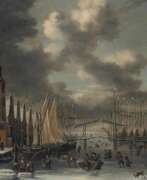

Thomas Heeremans was a Dutch painter and art dealer. He is known for his landscapes of winter scenes, cityscapes, harbor scenes, beach views, river views and village scenes. He was influenced by Klaes Molenaer, a slightly older painter also from Haarlem.


Abraham Janssens was a Flemish painter, who is known principally for his large religious and mythological works, which show the influence of Caravaggio. He was the leading history painter in Flanders prior to the return of Rubens from Italy.


Albert Jansz. Klomp was a Dutch painter of the Golden Age of Dutch painting who specialised in painting rural landscapes with animals.
Albert Klomp's paintings resemble those of Paulus Potter. Both artists have similar subjects and style, and Klomp's work has been erroneously attributed to Potter in the past.
Klomp's typical pastoral landscapes can be seen in many of the world's museums.
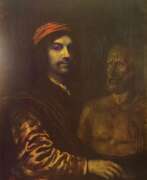

Philips Koninck was a Dutch landscape painter and younger brother of Jacob Koninck.
He painted chiefly broad, sunny landscapes, full of space, light and atmosphere; they are seen from a high perspective, allowing a prominent view of the sky. Portraits by him, somewhat in the manner of Rembrandt, also exist; there are examples of these in the galleries at Copenhagen and Oslo.
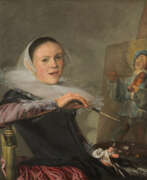

Judith Jans Leyster, a Dutch portrait painter of the Golden Age, was the first woman in the ranks of the Harlem Guild of St. Luke's. She painted still lifes, lively portraits, and genre scenes of taverns with drunks and people having fun. Several of her canvases depict women at home, which was a novelty for painting in the 1620s and 1630s.
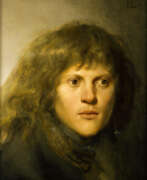

Jan Lievens was a Dutch painter, draughtsman, and engraver of the Golden Age and a member of the Guild of St. Luke in Antwerp.
It is known that while still very young, at the age of twelve, Lievens already created skillful paintings that amazed art lovers of Leiden. He was later friendly with Rembrandt, shared a studio with him, and painted in a similar style. Lievens was also a court painter in England and elsewhere.
Jan Leavens created genre scenes, landscapes, ceremonial portraits and sketches on various themes, as well as religious and allegorical images, which were already highly valued during his lifetime.


Adrien Manglard was a French marine painter and printmaker who worked most of his life in Italy.
He was a member of the Royal Academy of Painting and Sculpture of France. The artist mainly painted coastal landscapes with ships and sailing ships. As a very skilled marine landscape painter, Manglard was very successful and in demand, and had many commissions for paintings.
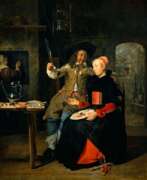

Gabriel Metsu was a Netherlandish painter of the Golden Age of Dutch painting, who painted mainly scenes of everyday life.
Metsu became one of the first members of the St. Luke's Artists' Guild in Leiden in 1648. He painted markets and outdoor interiors or genre scenes. He also produced many paintings of young women engaged in domestic tasks, often using his wife as a model, as in his painting St. Cecilia (1663).
In addition to genre, Gabriel Metsu was also engaged in portrait and historical painting, painted still lifes.
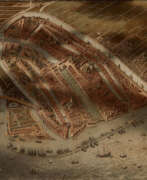

Jan Christiaensz. Micker was a Dutch landscape painter of the Golden Age of Dutch painting.
Jan Micker worked as a painter from 1618 until his death. He was the first teacher of Jan Baptist Wenix and painted staffage in the paintings of Jan Franz Dammeroen, Hans Jurriens van Baden and Joachim Goverts Kamphuizen. His most famous painting is Vogelflücht, which depicts Amsterdam from a bird's eye view. The painting was created around 1652 and is now in the Amsterdam Museum.
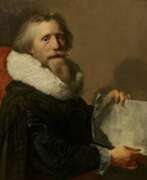

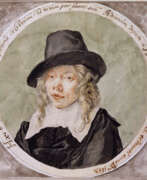

Isaac van Ostade was a Dutch painter. He was the brother and pupil of Adriaen van Ostade, who influenced his first works. Despite his short lifespan, he left around 100 paintings which deal with motifs similar to those of his brother, with whom they are often confused. They depict battles and rural scenes. After 1640 his pictures show rural life on the streets and inn scenes. The figures now increasingly take center stage in his paintings.
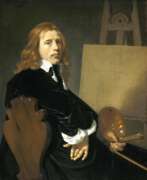

Paulus Potter was a Dutch painter who specialized in animals within landscapes, usually with a low vantage point.
Before Potter died of tuberculosis at the age of 28 he succeeded in producing about 100 paintings, working continuously.
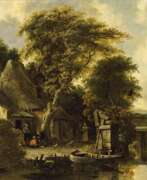

Salomon Rombouts was a Dutch painter of the Dutch Golden Age of painting.
Salomon Rombouts was the son and pupil of the landscape painter Gillis Rombouts and worked in his style. He mainly created landscapes with forests and architecture. The influence of Jacob van Reisdal is noticeable in Rombouts' work.
In 1678 he became a member of the Harlem Guild of St. Luke's. Around 1681 he left for Italy and settled in Florence.
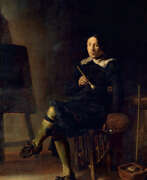

Cornelis Saftleven was a Dutch painter who worked in a great variety of genres. Known in particular for his rural genre scenes, his range of subjects was very wide and included portraits, farmhouse interiors, rural and beach scenes, landscapes with cattle, history paintings, scenes of Hell, allegories, satires and illustrations of proverbs.
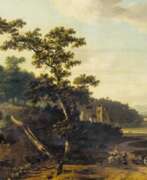

Jan Gabrielsz Sonjé was a Dutch painter of the Dutch Golden Age, specialising in landscapes.
Jan Gabriel Sonjé was a pupil of Adam Pijnacker. In 1646 he became a member of the Guild of St. Luke in Delft. And in 1654 he moved to Rotterdam.
Saunier painted vast expanses of mountain and forest landscapes, often in the Italian manner. His style is characterised by the clarity of the sky and landscape, with silvery clouds in contrast to the dark foreground. The trees are clearly distinguishable and the figures and animals are sometimes so well done that they remind one of Karel Dujardin. He also painted river landscapes in the style of Hermann Saftleven, but of a lower quality.


Hendrik Martenszoon Sorgh was a Dutch genre painter of the Dutch Golden Age of painting.
Hendrik Martenszoon Sorgh became a master of the Guild of St. Luke in 1636, and became its head in 1669. In his works, Sorg depicted peasant interiors, market scenes, and kitchens with their furnishings. He also painted portraits, nautical and historical scenes.
